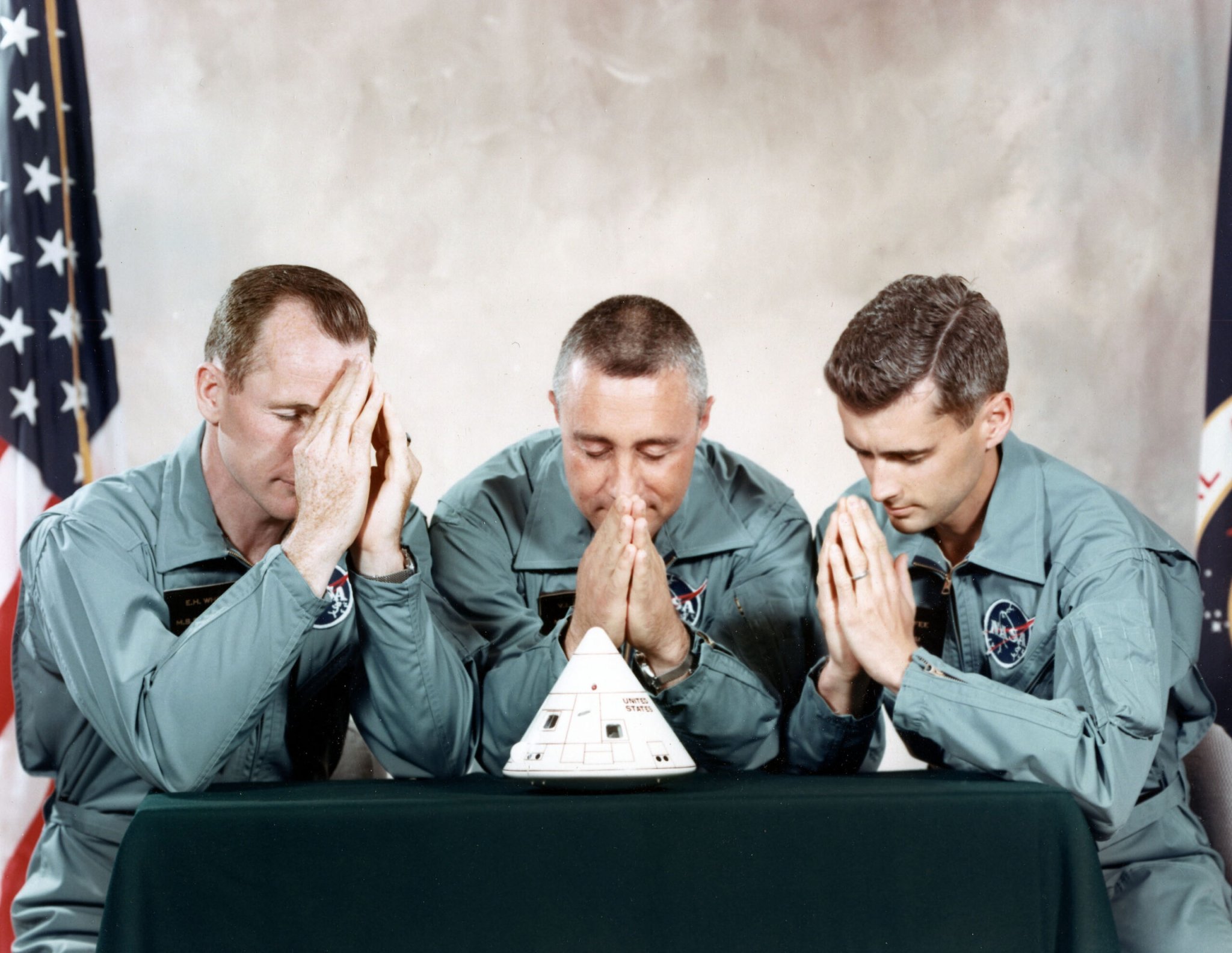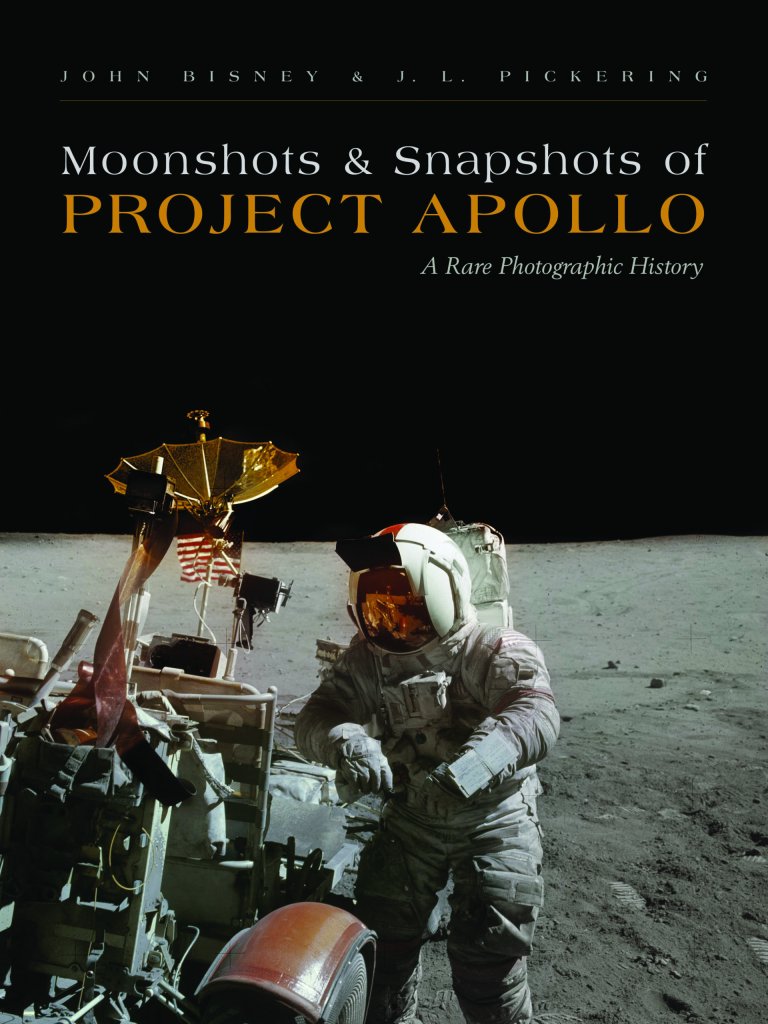

John Bisney and J. L. Pickering’s latest, “Moonshots & Snapshots of Project Apollo,” is a stunning look at the Apollo program. This follow up book to “Spaceshots & Snapshots of Projects Mercury & Gemini” showcases not only uncommon NASA images from the Apollo program, but images from journalists and photographers that rarely, if ever, make it into photo essays about the lunar landing program. The selection of images is brilliant, offering a uniquely intimate look at Apollo. The NASA images are less common, showing the astronauts’ candid moments in aircraft or quietly contemplating a pending lunar launch. These agency images are complimented by photographs from journalists and photographers, giving a different inside view on historic moments like Apollo 16’s launch.
Throughout the book, Bisney and Pickering explain the images, shedding light on little details few would notice let along think to ask about. (My personal favourite was the explanation behind the red helmets on Apollo 9 — I never knew that the Lunar EVA helmets were red and covered with white beta cloth for the lunar landing missions. Scott and Schweickart’s helmets just didn’t have that covering!) You don’t have to be an Apollo fanatic or even a space person to appreciate the story this book tells through its selection of images. Regardless of your own fandom, this is an extremely powerful collection.
On a related note to the power of Apollo images, my friend Trace Dominguez put together a fantastic response video to Kipp Teague posting the full Apollo Hasselblad magazines on Flickr last month. It’s a beautiful expression of how these photographs can affect everyone in a different but meaningful way.

Buy “Moonshots & Snapshots of Project Apollo” on Amazon. It would make a great holiday gift, or a worthwhile indulgence for yourself!
One of several gag photos taken at the Manned Spacecraft Center (MSC) on April 1, 1966, during the session for the Apollo 1 crew portrait. After a meeting during which the crewmen expressed concerns about the flammable material in the cabin, the men gave a copy of the photo to NASA’s Joe Shea. The caption read, “It isn’t that we don’t trust you, Joe, but this time we’ve decided to go over your head.”

The Saturn’s tumbling empty second (S-IVB) stage is seen from Apollo 7, following the crew’s rendezvous with it on the afternoon of October 12, 1968. The astronauts approached to within seventy feet as part of a simulated rescue by the Apollo command module (CM) of a stranded lunar module (LM) in lunar orbit, which was also a key test of their main engine. They hovered nearby for about thirty minutes. The stage’s single J-2 engine is on the aft end. The four open adapter panels would be jettisoned on missions carrying an LM. The S-IVB decayed in Earth orbit on October 18, 1968.

News photographers record the launch of Apollo 8 from the LC-39 Press Site.

In this photo from Apollo 9 taken by David Scott from the command module (CM), Rusty Schweickart reaches the top of the handrail. The lunar module (LM) rendezvous radar antenna’s shaft is at right. Once outside, Schweickart used the radio call sign “Red Rover” because of his rust-colored hair. He was attached to the LM with a twenty-five-foot tether.

During the rollout of the Apollo 10 Saturn V, three service arms extend to the vehicle from the Launch Umbilical Tower (LUT). The S-II intermediate arm at top provided fueling and was retracted at launch; the S-II aft arm (center), which provided access, and the S-IC forward arm (below, providing pneumatic, electrical, and air-conditioning interfaces) were both retracted before launch. Two of the eight ullage motors are visible on the Saturn’s interstage, to the left of the center arm. These motors fired to briefly nudge the stage forward, to settle its fuel prior to ignition of its five J-2 main engines. The two fairings to the right of the service tunnel above the interstage housed liquid hydrogen feed lines.

Apollo 11 commander Neil Armstrong arrives at Patrick Air Force Base (AFB) on June 17, 1969, from Ellington AFB. Deke Slayton was in the second seat on the flight from Houston. Armstrong had flown the Lunar Landing Training Vehicle (LLTV) twice the day before at Ellington, bringing it to three hundred feet before practicing powered descents to the moon. All three crewmen spent time in the Kennedy Space Center (KSC) simulators on June 17. That evening, after the day’s flight readiness review, Apollo Program Director Sam Phillips announced that the launch was on for July 16.

Grumman Aerospace technicians in the crew compartment of LM-6 on August 27, 1969, during closeout operations inside the Spacecraft Lunar Module Adapter (SLA) near the top of the Apollo 12 Saturn V stack. They would leave with the “Remove Before Flight” ribbons on the lunar module’s (LM) windows and instrument panels (behind them). Rollout to Pad 39A occurred twelve days later.

Apollo 13 Command module pilot (CMP) Jack Swigert, suited for launch on April 11, 1970. A lifelong bachelor with an eye for women, Swigert, thirty-eight, was turned down by NASA twice before being selected in 1966. He was elected to the US House of Representatives from Colorado in 1982, but he died from cancer before taking office.

The Apollo 14 Saturn V is launched from Pad 39A on January 31, 1971.

Apollo 15 astronaut Jim Irwin photographs the Lunar Roving Vehicle (LRV) at Geology Station 2, during extravehicular activity (EVA) 1 on July 31, 1971.

Apollo 16 as seen from the LC-39 Press Site, seconds after liftoff at 12:54 p.m. (EST) on April 16, 1972. Spectators sweltered in 88-degree-Fahrenheit temperatures, with 44 percent humidity— the hottest of any Apollo launch.

Much of the Apollo 17 Lunar Module Challenger’s descent stage is covered with gold Mylar thermal blankets, which were hand-crinkled to minimize the heat transfer between layers. At left, a white blanket protects the Modularized Equipment Stowage Assembly (MESA) pallet, containing lunar surface tools, sample containers, and film and TV cameras. Rover tracks can be seen in this photo, taken on December 11, 1972.

View from the Launch Umbilical Tower (LUT) of the fifty-six-foot-tall payload shroud, during the Skylab 1 rollout on April 16, 1973. The damper arms extending to the shroud mitigated movement caused by winds. The swing arms and umbilical connections to the Orbital Workshop (OWS) and second stage are below. The uppermost swing arm, which had been used to access the Apollo command modules (CM) for manned launches, was removed for this launch.

Xenon floodlights illuminate the twenty-two-story-tall Skylab 3 Saturn IB and Launch Umbilical Tower (LUT) at Pad 39B at dusk on July 27, 1973. This angle looks west. Within hours, the launch vehicle would be fueled for the second time in eight days; the first, on July 20, was part of the combined countdown and countdown demonstration test (CDDT). The Holloway Corporation of Titusville, Florida, built the “milkstool” pedestal.

